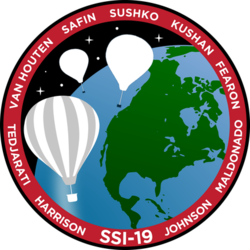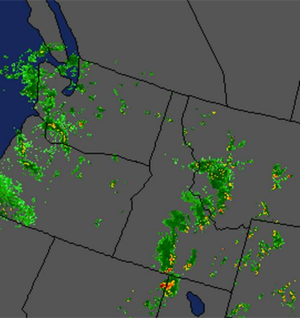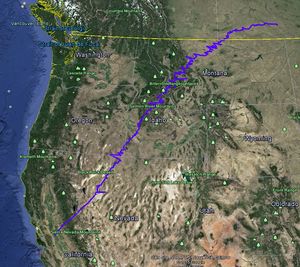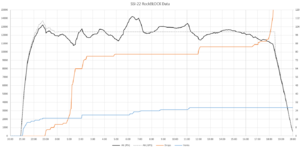SSI-19
| SSI-19 | ||||
|---|---|---|---|---|

| ||||
| Launch date | May 16th 2015, 6:32 PM PDT | |||
| Launch site | Laird Park, Modesto, CA | |||
| Launch coordinates | 37.56158, -121.14993 | |||
| Flight duration | 15 hrs, 11 minutes | |||
| Landing coordinates | 37°50.87' N 119°5.28' W | |||
| ||||
SSI-19 was the 19th launch of SSI Balloons. SSI-19 flew for just over 15 hours and to an altitude of 119,932 ft - breaking SSI's altitude record. The launch was a demonstration of the physical feedback found at high altitude with a precision filled latex balloon. The payload maintained an altitude of approximately 118,000 feet merely by passive feedback and no active control - it was degraded by UV radiation and descended shortly after sunrise. SSI-19 landed in Yosemite just east of Grant Lake after a flight of 15 hours.
Flight Profile
SSI-19 was based on a flight method that was first successfully flown by the California Near Space Project (CNSP). The principle of the launch is inflating a large latex balloon (In the case of SSI-19, a 1600g) to a very low lift capacity (365g payload, ~140g free lift) to launch a very light payload. By barely filling the balloon and providing a very light payload, the balloon is able to ascend to a very high altitude (110,000-120,000 ft) where there is a positive feedback loop, allowing the balloon to equilibrate due to natural phenomena (no active control mechanism).
Payload Specifications
The SSI-19 payload was, as needed, a very barebones set of electronics. It included an APRS BigRedBee transmitter using the callsign of balloons team member Iskender Kushan (KK6MIR), a GPS for position reporting, a sizable lithium-ion battery, and a heater made of nickel-chromium (nichrome) wire. In total, the payload had a mass of about 365g. It was the first balloon to be launched during the launch of SSI-19, SSI-20, and SSI-21. CNSP graciously brought their mass-flow meter to fill the SSI-19 latex balloon to a precise lift capacity (a mission-critical aspect of this launch).
Launch site
The launch was conducted at Laird Park, just west of Modesto, CA, a site frequented by the balloons team. The team left campus at 10 am, arriving just after 11:30 am. The payload was essentially flight-ready, requiring only minor pre-flight additions and verification of system fidelity. The APRS transmitter was verified for flight-readiness by ensuring transmission on the ground, the payload was sealed, and just prior to launch, the heater was hard-wired to the battery pack (for constant heating).
Filling of the 1600g Hwoyee balloon began at around 5:30 pm. Filling was coordinated in conjunction with CNSP personnel, who used their mass-flow meter to fill the balloon with the appropriate volume of Helium as calculated and verified by SSI members. Filling was challenging due to higher than expected ground wind speeds. After filling, launching was additionally challenging due to powerful east-bound winds, which pushed the balloon nearly into the ground on multiple occasions. During a moment of south-bound winds, the balloon was released from the north end of Laird Park (in order to clear the southern tree line) and ascended at a nominal velocity.
The Flight
The fast ascent rate of the balloon proved to be an immediate test of the resilience and fidelity of the autonomous altitude control algorithm. As soon as the balloon was launched, the team began to pack up while waiting for the first message from the payload. The first message confirmed that the payload was slowly being incentivized to vent gas and slow its ascent. By the time the team had packed up and started driving out, the payload had vented gas a total of 7 times, decreasing its ascent rate to < 1.5 m/s. The algorithm was pre-programmed to maintain an altitude between 12km and 14km, as this range of altitudes was chosen to optimize the wind conditions the balloon would experience (fastest winds, most predictable, and most appropriate direction). After the balloon roughly levelled off, the team armed the ballast mechanism over satellite comms. The GPS lock was lost at exactly 12:00 am PDT (due to a snippet of code in the GPS library relying on date, and being unable to cope with the month turnover of May to June). Nonetheless, the satellite communications module transmitted GPS coordinates (albeit with a subpar ~ 4km accuracy).
The payload flew at considerable speed, crossing into Nevada after two hours in the appropriate altitude range. The flight continued through Nevada northward, cutting through the southeastern corner of Oregon before entering Idaho around 2:20 am PDT. The payload spent considerable time in central Idaho, and transmitted data suggesting considerable venting and ballast dropping occurring in this area. Unbeknownst to the team until the balloon was out of Idaho airspace, the balloon flew through a class 3 thunderstorm, experiencing considerable turbulence. Despite the tremendous up and downdrafts, the balloon was able to autonomously maintain its altitude within its defined range, at the cost of considerable gas and ballast.
After spending a few hours in the thunderstorm, the balloon entered Montana at around 8:00 am PDT, continuing on a north/northeast trajectory. At 2:39 pm PDT, and at over 1,000 miles from the launch site, the balloon entered Canadian airspace in Saskatchewan province. At this point the balloon began a more prominently eastward flight path along the Canadian border. At around 6:36 PDT, the balloon began a steady descent just north of the North Dakota/Montana border. Based on data transmitted from the balloon, it was clear that the system had ran out of ballast material and was thus unable to drop weight to compensate for lost lift as night was arriving and hence began to fall. The ballooon fell slowly for about an hour, finally terminating its flight at around 8:35 pm EDT, landing in a field.
Debriefing
The ability of the balloon to maintain altitude on its own through almost the entire flight to such precision was a testament to the resilience of the technology. Nevertheless, problems were encountered, including the following:
- The power draw for heating was quite high; the battery started at a voltage of ~ 4.34 V and was around ~ 3.40 V upon landing. 3.20 V is the point at which the flight control system ceases to function; thus, for longer flights, more power is needed. Proposed improvements included more battery storage and, more importantly, solar panels for power regeneration.
- This flight offered an indication of how far the preloaded quantity of ballast was able to take the balloon. Granted, the turbulence experienced over Idaho resulted in considerable usage of ballast, but the fact that this occurred suggested that significantly more ballast would be required for longer journeys.
- Gas venting can also be amended; a 3-inch neck was used to allow for high volumes of gas to be vented, but this could have been reduced to a neck diameter as small as 1 inch and compensated for with a larger vent time. Venting for 5 seconds at a time with a 3 inch neck caused unnecessarily large volumes of gas to be vented.
- Better payload insulation is needed. SSI-18 used a payload wrapped in AeroGel Cryogel blanket, which was so insulative that its heaters did not need to turn on for over 10 hours. A shrinking budget and smaller timeframe did not permit the team to put Aerogel on this flight, but its potential value to future payload containers was demonstrated.
Milestones
- First international launch of SSI Balloons
- Longest flight of SSI Balloons (as of September 2015)
- Longest ground distance traveled by any SSI Balloons mission (as of September 2015)
Gallery
| Balloon Launches | |
|---|---|
| 2014-15 | SSI-19 • 20 • 21 • 22 |
| 2015-16 | SSI-23(a) • 24 • 25 • 26 • 27 • 28 • 29 • 30 • 31 • 32 • 33 • 34 • 35 • 36 • 37 • 38 • 39 • 40 • 41 • 42 • 43 |
| 2016-17 | 44 • 45 • 46 • 47 • 48 • 49 • 50 • 51 • 52 |
| 2017-18 | |
| 2018-19 | 83 • 86 • 87 • 90 • 91 |
| 2019-20 | 92 • 93 • 97 |
| V • E | |


